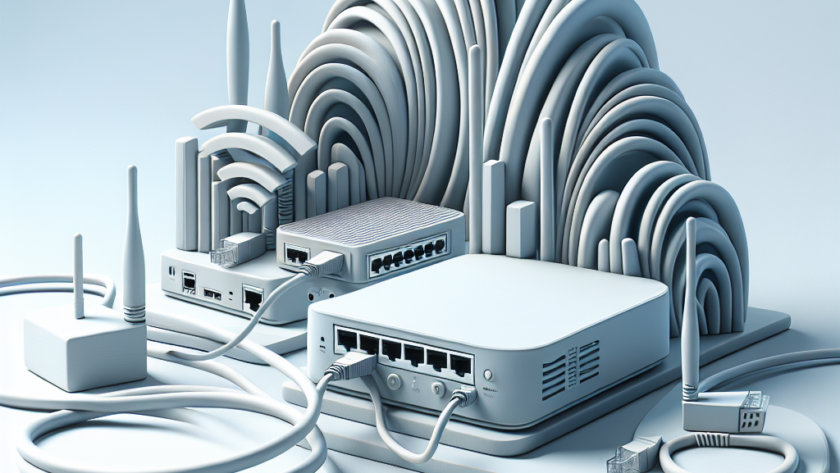Understanding the Essentials: Routers vs Gateways
In today's digitally interconnected world, having a robust understanding of network devices is crucial. Among these devices, routers and gateways play pivotal roles. However, the terms are often used interchangeably, leading to confusion. Let's delve deep into their differences and individual functionalities to clear the air.
Basic Definitions
Before we dive into the specifics, let's establish the basic definitions of each device to set a solid foundation:
| Device | Definition |
|---|---|
| Router | A router is a networking device that forwards data packets between computer networks, typically connected to multiple data lines from different networks. |
| Gateway | A gateway is a network node that serves as an access point to another network, often translating data from one protocol to another. |
Key Differences Between Routers and Gateways
One of the main differences between routers and gateways lies in their primary functions:
Functional Role
- Router: The primary function of a router is to route data packets along the most efficient paths from the source to the destination within the same or different networks. This ensures optimal data transfer speeds and reliability.
- Gateway: A gateway, on the other hand, serves as a bridge between different networks, potentially using different protocols. It translates data from one protocol to another, allowing disparate networks to communicate seamlessly.
Network Layers
Routers and gateways operate at different layers of the OSI (Open Systems Interconnection) model:
- Router: Operates at the Network Layer (Layer 3) of the OSI model. It deals with IP addresses and routing packets based on them.
- Gateway: Operates at multiple layers of the OSI model, often including the Application Layer (Layer 7). A gateway can translate protocols at this layer, enabling diverse communication.
Usage Scenarios
The typical usage scenarios also help distinguish between routers and gateways:
- Router: Commonly used in home and office networks to connect multiple devices to the internet. Routers manage data traffic and provide features like NAT (Network Address Translation) and DHCP (Dynamic Host Configuration Protocol).
- Gateway: Frequently employed in complex networks where different systems and protocols must communicate. For example, an IoT (Internet of Things) environment may utilize a gateway to connect various smart devices using different standards.
Technical Characteristics
Exploring the technical characteristics of each device provides further insight:
Routing Tables and Protocols
- Router: Maintains a routing table that keeps track of various available routes to direct data packets efficiently. Common protocols used by routers include BGP (Border Gateway Protocol), OSPF (Open Shortest Path First), and RIP (Routing Information Protocol).
- Gateway: Works with higher-level protocols such as HTTP (HyperText Transfer Protocol) and FTP (File Transfer Protocol), depending on its function. For example, a VoIP (Voice over Internet Protocol) gateway handles SIP (Session Initiation Protocol).
Hardware and Software
Routers and gateways can differ significantly in their hardware and software configurations:
- Router: General-purpose devices that may come as standalone equipment or integrated into other devices like modems. They include routing software to manage network traffic.
- Gateway: Can be specialized hardware or software designed for specific tasks such as VoIP or security gateways. Hardware gateways can include components for protocol translation and secure connections.
Security Implications
Both routers and gateways have notable security implications:
Security Features
- Router: Typically includes firewall capabilities, VPN (Virtual Private Network) support, and intrusion prevention systems to protect the network from external threats.
- Gateway: May offer advanced security features like protocol filtering, deep packet inspection, and secure protocol translation, enhancing the security of inter-network communications.
Examples in Real World Applications
Understanding real-world applications helps solidify the theoretical differences:
Router Example
Home Network: In a typical home setup, an ISP (Internet Service Provider) provides a router that connects all household devices to the internet. This router manages which device accesses the internet and steers data packets accordingly.
Gateway Example
Enterprise Environment: In a corporate setting, a gateway may connect the internal company network to a cloud service provider. This gateway will translate data between the internal protocols and the cloud provider's protocols, ensuring seamless data exchange and access control.
Conclusion
While routers and gateways perform different functions in the network ecosystem, each plays an essential role. Routers handle efficiently directing data within and between networks, while gateways enable communication between disparate networks and protocols. Understanding these distinctions is key to optimizing network performance and ensuring seamless connectivity across varied devices and systems.

